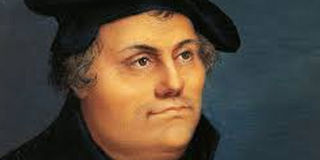The birth of Protestantism, a revolution 500 years ago

Martin Luther
Tuesday marks five centuries since the start of the process that led Protestants to break away from the Roman Catholic Church, a revolution for the Christian religion.
Here are some key facts about Protestantism and its birth in a small German town.
- The start: October 31, 1517 -
This is the date that German theologian Martin Luther published his groundbreaking "95 Theses" of criticism of the Catholic Church.
His brazen challenge to the powerful Church created shock waves that eventually changed the face of Christianity.
His main complaint was against the Catholic concept of "indulgences" whereby a repentant sinner could reduce punishment in purgatory through monetary contributions to the Church.
Luther, then in his early 30s, also attacked papal abuses and questioned the place of saints.
Legend says that he nailed his list to the door of a church in town of Wittenberg, where Luther was a theology professor.
He was excommunicated just over three years later but the Reformation had been launched: his message spread quickly, disseminated by the developing printing press.
The Reformation caused major upheaval in Europe, leading to wars, persecutions and exoduses, including the departure of the Pilgrims for what was later to become America.
King Henry VIII's Britain broke ties with the Catholic Church in 1534 with the establishment of the Church of England.
The deadliest of Europe's religious conflicts was the Thirty Years' War which ended in 1648 and after which religion's role in European politics was reduced.
Differences in belief
There are many theological differences between Protestants and Roman Catholics, including:
- Protestants believe the Bible alone is the highest authority in matters of faith. Catholics acknowledge the combined authority of the Bible and traditions of the Church.
- Catholics consider the pope has full power over the Church, which is not acknowledged by Protestants.
- Catholics also pray to saints and place more doctrinal importance on the holy communion rite, believing the bread and wine is transformed into the body and blood of Jesus Christ, a 'transubstantiation' to which Protestants do not adhere.
- For Protestants salvation is through faith alone while Catholic doctrine says "good works" can influence one's standing with God.
- The Catholic Church reserves the priesthood for men, who must remain celibate. Within Protestantism, clerics can marry and have children, and in many churches women have been admitted to the priesthood and hierarchy.
Many denominations
Over time the Protestant movement diversified into three main branches: Lutheranism, Calvinism and Anglicanism.
Sizeable Lutheran congregations, which adhere closely to principles established by Luther, are located in Scandinavian countries as well as in Germany, Ethiopia, Indonesia, Tanzania and the United States.
Calvinists are inspired by French theologian John Calvin, who in 1536 founded the Reformed Church in Geneva. This is present primarily in Europe, North America, South Africa and Australia.
Anglicanism evolved from the Church of England and can be found on almost all continents.
Within these branches are many denominations including Baptists, Evangelicals, Methodists, the US-based Amish people that renounce modern technology, and various Churches based in Africa.
Still more Catholics
The precise number of Protestants is difficult to establish, given the number of Churches and offshoots, but the independent Pew Research Center estimates there were more than 800 million in 2011.
However Protestants made up only 37 percent of Christians while Catholics comprised around 50 percent, its says.
About a third (2.3 billion) of the world's people were Christians in 2015, according to figures on its site, making this religion the largest, with Islam second at 24 percent of the population (1.8 billion people).




